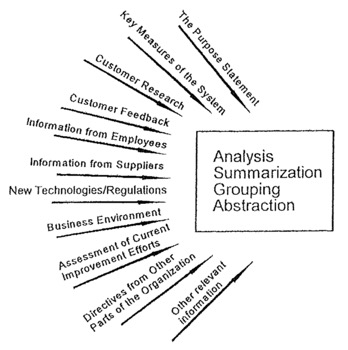In a recent blog post (here), I shared how Associates in Process Improvement transformed Dr. Deming’s theory of Organizations Viewed as a Production System into a five-part approach known as Quality as an Organizational Strategy.
In this series, we’ll take a deeper look at each of the five activities including Purpose, Mission, Vision, and Beliefs; Organization Viewed as a System (includes measurement); System for Obtaining Information; Planning; and Managing Improvement Efforts.
Activity 3 – System for Obtaining Information
Most organizations are data-rich and knowledge-poor. Many sources can contribute information about the customer and their needs as well as the performance of your organization. Having a system of activities to obtain information to support understanding your organization and to act as inputs to your planning process is helpful for learning and focusing attention.
Most organizations already have many sources of information. These include performance data, customer complaints and compliments, and employee input. How can you convert this data into useful information?

Figure – Sources of Information (API-QBS)
For performance data, use the last 24 months and display the data over time in a Shewhart Statistical Process Control Chart. This allows leaders to see whether a process is meeting their goal, whether the data is random and predictable, and to make the correct decision on how to act.

Figure. Example Shewhart Chart (source).
Raw employee and customer feedback data are rich in identifying themes for learning. Summarizing these data into themed categories and displaying them in a Pareto chart can help prioritize attention to the big opportunities.

Figure. Pareto Chart
It’s not uncommon to find areas without built-in systems for collecting information. This may include current improvement capability, input from core vendors, a scan of best practices and new research, regulatory changes, and the current state of active improvement project progress. Understanding what inputs are valuable and having a holistic view to support your planning is important.
A summary of these inputs is prepared and organized in a pre-work document to inform your planning process. It’s okay to start with what you have and then build a more comprehensive system over time. In the future, a proactive approach to identifying the information needed, collecting the data, and summarizing the findings can make the process easier to execute and support regular planning processes.
In Activity 4, I’ll look at the planning process.
COMING in 2024: Quality as an Organizational Strategy: Building a System of Improvement from Lloyd Provost, Cliff Norman, and Dave WIlliams
—
If this was helpful, share and include me @DaveWilliamsATX. Sign up here to receive a monthly email from me that includes all my blog posts and other Improvement Science resources I think you’d appreciate.
